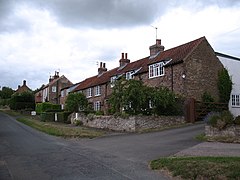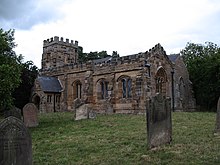Whenby
| Whenby | |
|---|---|
 Main street, Whenby | |
Location within North Yorkshire | |
| Population | 222 (2011 census)[1] |
| OS grid reference | SE630698 |
| Unitary authority | |
| Region | |
| Country | England |
| Sovereign state | United Kingdom |
| Post town | York |
| Postcode district | YO61 |
| Police | North Yorkshire |
| Fire | North Yorkshire |
| Ambulance | Yorkshire |
| UK Parliament | |
Whenby is a civil parish and village in North Yorkshire, England. The village and parish is largely agricultural in nature, and although the village has a parish church. it was declared redundant in 1983. It is now maintained by the Churches Conservation Trust.
History
Whenby lies between Sheriff Hutton and Brandsby, on Main Street, and a little to the east of the Howardian Hills.[2] According to the 2011 census, it has an area of 4,860 acres (1,966 ha),[1] and is situated approximately 12 miles (19 km) north of York and 8 miles (13 km) east of Easingwold.[3] Although Whenby was recorded in the Domesday Book, no particular details are shown about the settlement.[4] The first art of the name derives from Old Norse Kona ( a woman) and the suffix by, which is Old English for steadings or farm, so literally Woman's Farm.[5][6]
The area was in the possession of the de Nevil family in the 13th century, and passed through several noble families (Moryn, Barton, Thomas etc) until it passed through marriage to the Radclyffe family of Derwentwater. However, the lands around Whenby were forfeited to the crown in 1715 after James Radclyffe, 3rd Earl of Derwentwater was found guilty of treason. Radclyffe took part in the Jacobite Uprising, was tried, found guilty, attainted and executed.[7]
Whenby has approximately 20 houses, most of these are old cottages, and all but three are on the north and east side of Main Street.[8] All surrounding land is farmland, and strict planning permissions prevent any development. The surface is undulating, and the soil generally a rich clay loam, and the parish is an average of 200 feet (61 m) above sea level.[2][9] Whilst parts of the parish are within the Howardian Hills AONB, the village itself is just outside it to the south.[10]

St Martin's Church is a redundant Anglican church, which still has its stained glass windows and fittings. It was built around 1400, although a church has existed on the site since 1250.[11] St Martins has a chancel, north aisle, porch, nave, mortuary chapel, and a tower, containing three bells. It was restored, at a cost of £700, in 1871, when a north aisle of stone was added. The principal entrance is by the north porch, though Pevesner described the south porch as its best feature.[12] There is a doorway of ancient date, which is generally supposed to have been used for public access to the church, or in connection with the priest's house. It is a grade II* listed building.[13] Although declared redundant in October 1983, it still forms part of the ecclesiastical parish of Dalby with Whenby,[11][14] and is maintained by the Churches Conservation Trust.[15]
Governance
In the Domesday Book, the settlement was recorded as being the Hundred of Bulford. This ceased to exist, and it was later recorded as part of the wapentake of Bulmer.[16] It was recorded as a parish within the Easingwold district of the North Riding of Yorkshire until 1974, when it was moved into North Yorkshire.[17][18] The area is represented in the United Kingdom Parliament as part of the Thirsk and Malton constituency.[19]
References
- ^ a b UK Census (2011). "Local Area Report – Whenby Parish (1170216959)". Nomis. Office for National Statistics. Retrieved 23 July 2018.
- ^ a b Page 1968, p. 211.
- ^ "Genuki: Whenby, Yorkshire (North Riding)". genuki.org.uk. Retrieved 30 June 2023.
- ^ "Whenby | Domesday Book". opendomesday.org. Retrieved 30 June 2023.
- ^ Smith, A. H. (1979) [1928]. The Place Names of the North Riding of Yorkshire. English Place Name Society. p. 31. OCLC 19714705.
- ^ Ekwall, Eilert (1960). The concise Oxford dictionary of English place-names (4 ed.). Oxford: Oxford University Press. pp. 79, 512. ISBN 0-19-869103-3.
- ^ Page 1968, pp. 212–213.
- ^ "Whenby" (PDF). colinday.co.uk. Retrieved 30 June 2023.
- ^ "Whenby, Hambleton". getoutside.ordnancesurvey.co.uk. Retrieved 30 June 2023.
- ^ "300" (Map). Howardian Hills & Malton. 1:25,000. Explorer. Ordnance Survey. 2015. ISBN 978-0-319-24552-1.
- ^ a b "Parish records of Whenby - Borthwick Catalogue". borthcat.york.ac.uk. Retrieved 30 June 2023.
- ^ Pevsner, Nikolaus (2002). Yorkshire North Riding. London: Yale University Press. p. 387. ISBN 0300096658.
- ^ Historic England. "Church of St Martin (1191384)". National Heritage List for England. Retrieved 30 June 2023.
- ^ "St Peter". achurchnearyou.com. Retrieved 30 June 2023.
- ^ "St Martin's Church, Whenby, North Yorkshire". visitchurches.org.uk. Retrieved 30 June 2023.
- ^ "Hundred of Bulford | Domesday Book". opendomesday.org. Retrieved 30 June 2023.
- ^ "Whenby North Riding". visionofbritain.org.uk. Retrieved 30 June 2023.
- ^ GUIDE NO. 6 NORTH YORKSHIRE GAZETTEER OF TOWNSHIPS AND PARISHES. Northallerton: North Yorkshire County Council. 1986. p. 33. ISBN 0 906035 29 5.
- ^ "Election Maps". www.ordnancesurvey.co.uk. Retrieved 30 June 2023.
On the left of the screen is the "Boundary" tab; click this and activate either civil parishes or Westminster Constituencies (or both), however, only two functions can be active at any one time.
Sources
- Page, William, ed. (1968). The Victoria history of the county of York, North Riding. London: Dawsons of Pall Mall for the University of London Institute of Historical Research. ISBN 0712903100.
External links
![]() Media related to Whenby at Wikimedia Commons
Media related to Whenby at Wikimedia Commons

